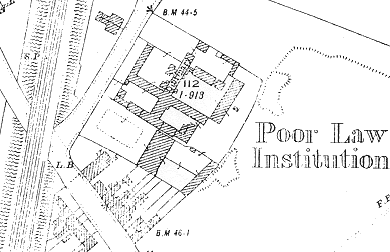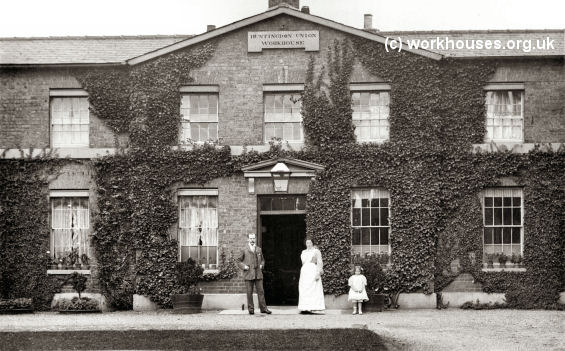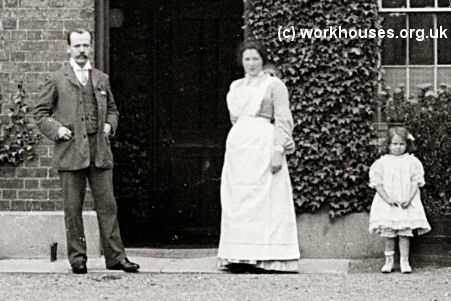Huntingdon, Huntingdonshire
Up to 1834
A parliamentary report of 1777 recorded parish workhouses in operation at Alconbury and Weston (for up to 20 inmates), Brampton (25), Connington (35), Ellington (12), Huntingdon—All Saints (20), Huntingdon—St Benedict (14), Ramsey (80), and Saltree [Sawtry] St Andrews & All Saints (30).
In 1824, it was recorded that:
The workhouse is situated in Priory Lane, and is pointed out by the following Inscription affixed to the north end of the building: "This Building and Premises, the Property of All Saints Parish, was made a Workhouse for the use of the Four Parishes in the Year 1804." The interior consists of a large day-room and sleeping-room for the men, and others for the women, who have also separate Wards when confined with sickness. The Master is allowed a certain sum for each pauper according to the price of provisions.
The premises on Priory Lane (now St Germain Street) had previously served as a County Bridewell.
After 1834
Huntingdon Poor Law Union was formed on 19th January 1836. Its operation was overseen by an elected Board of Guardians, 35 in number, representing its 33 constituent parishes as listed below (figures in brackets indicate numbers of Guardians if more than one):
County of Huntingdon: Huntingdon All Saints - Huntingdon - St Bendict, Huntingdon - St John, Huntingdon - St Mary, Abbots Ripton with Wennington, Alconbury, Alconbury Weston, Barham, Brampton, Buckworth, Conington, Coppingford, Easton, Ellington, Godmanchester (2), Great Raveley, Great Stukeley, Hartford, Humerton, King's Ripton, Leighton Bromswold, Little Raveley, Little Stukeley, Ramsey (2), Sawtry All Saints, Sawtry St Andrew, Sawtry St Judith, Spaldwick, Steeple Gedding, Upton, Upwood, Wolley, Wood Walton.
The population falling within the union at the 1831 census had been 16,859 with parishes ranging in size from Little Raveley (population 54) to Huntingdon itself (combined population of four parishes of 3,267). The average annual poor-rate expenditure for the period 1833-35 had been £11,782 or 14s.0d per head of the population.
The new Huntingdon Board of Guardians had their first meeting on 25th January, 1836, at the George Inn in Huntingdon. The following month they resolved to replace the existing parish workhouses within the union by a central workhouse for 200 inmates. The new building was designed by Sampson Kempthorne and was based on his 200-pauper model plan. It was built at a site at Walnut Common in Huntingdon. The building contractors were Messrs Edward and William Harratt. The building work was completed at the end of May 1837 and the first inmates were received that autumn.

Huntingdon workhouse site, 1925
The main part of the workhouse were based on a cruciform plan with a two-storey front block, with a central link block behind leading to a main accommodation block behind. Running to the rear from the centre was a dining hall above which was erected an infirmary in 1842. Later additions included a large three-storey children's block at the eastern front of the site in 1855, an aged men's block (later a female infirmary block) at the north of the site in 1868, and a laundry at the north-east of the site in around 1900.

Huntingdon workhouse, c.1905.
© Peter Higginbotham.

Huntingdon workhouse master and matron, c.1905.
© Peter Higginbotham.
The original system drains of installed at the workhouse seems to have been a cause of problems and they were replaced in 1875. If the following description of the old drains is anything to go by, it must have been a very unhealthy (and smelly!) place up until then.
The workhouse later became a Public Assistance Institution known as Walnut Tree House. After 1948, it joined the NHS as Petersfield Hospital. The buildings have now been demolished and housing stands on the site.
Staff
Inmates
Records
Note: many repositories impose a closure period of up to 100 years for records identifying individuals. Before travelling a long distance, always check that the records you want to consult will be available.
- Cambridge Archives and Local Studies, Box SH 1009, Shire Hall, Castle Hill, Cambridge CB3 0AP. The extensive holdings include: Board of Guardians' minutes (1836-1920); Admission and discharge registers (1837-1930); Creed Registers (1885-1931); Births register (1837-1949); Deaths register (1848-1946); Punishment book (1914-43); Porter's admission and discharge book (1883-97); Medical Officer's examination books (1924-52); Register of lunatics (1906-11); Workhouse vaccination register (1886-1940); etc.
Bibliography
- The Builder, 29th May, 1875.
Links
- None.
Unless otherwise indicated, this page () is copyright Peter Higginbotham. Contents may not be reproduced without permission.


